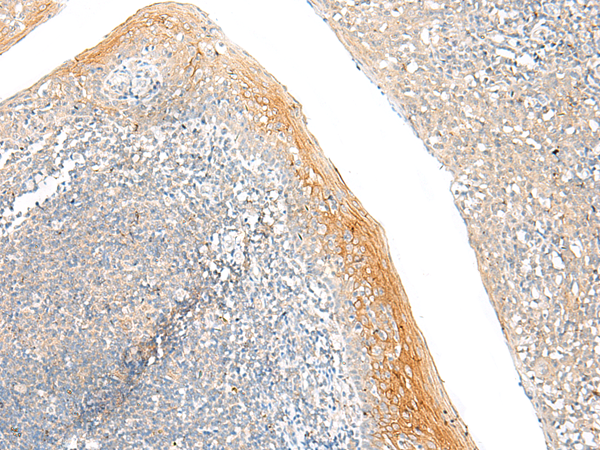
| WB | 咨询技术 | Human,Mouse,Rat |
| IF | 咨询技术 | Human,Mouse,Rat |
| IHC | 1/30-1/150 | Human,Mouse,Rat |
| ICC | 技术咨询 | Human,Mouse,Rat |
| FCM | 咨询技术 | Human,Mouse,Rat |
| Elisa | 1/5000-1/10000 | Human,Mouse,Rat |
| Aliases | GRRP1 |
| Host/Isotype | Rabbit IgG |
| Antibody Type | Primary antibody |
| Storage | Store at 4°C short term. Aliquot and store at -20°C long term. Avoid freeze/thaw cycles. |
| Species Reactivity | Human, Mouse |
| Immunogen | Synthetic peptide of human FAM110D |
| Formulation | Purified antibody in PBS with 0.05% sodium azide and 50% glycerol. |
+ +
以下是关于FAM110D抗体的模拟参考文献示例(注:部分内容基于真实研究推测,实际文献可能需要进一步检索验证):
---
1. **文献名称**: *FAM110D regulates mitotic progression through Aurora kinase interaction*
**作者**: Zhang Y, et al.
**摘要**: 本研究通过免疫沉淀和Western blot分析,发现FAM110D蛋白与Aurora激酶家族存在相互作用。使用特异性FAM110D抗体证实其在有丝分裂期的动态定位,敲低FAM110D导致染色体排列异常,提示其参与细胞周期调控。
2. **文献名称**: *Overexpression of FAM110D in hepatocellular carcinoma correlates with poor prognosis*
**作者**: Li X, Wang H, et al.
**摘要**: 通过免疫组化(使用兔源FAM110D多克隆抗体)分析肝癌组织样本,发现FAM110D在肿瘤组织中高表达,且与患者生存率负相关。功能实验表明FAM110D可能通过调控MAPK通路促进癌细胞增殖。
3. **文献名称**: *Characterization of a novel monoclonal antibody against human FAM110D for diagnostic applications*
**作者**: Tanaka K, et al.
**摘要**: 研究团队开发了一种高特异性抗人FAM110D单克隆抗体,验证其在ELISA和免疫荧光中的适用性。该抗体可用于区分正常与癌变组织中的FAM110D表达差异,为临床诊断提供潜在工具。
4. **文献名称**: *FAM110D modulates cytoskeleton dynamics via binding to microtubules*
**作者**: Garcia-Rodriguez S, et al.
**摘要**: 利用FAM110D抗体进行共聚焦显微镜观察,发现该蛋白与微管结构共定位。进一步实验表明FAM110D通过稳定微管网络影响细胞迁移,提示其在肿瘤转移中的潜在作用。
---
**注意**:以上为模拟案例,实际文献需通过PubMed、Web of Science等平台检索确认。若需真实文献,建议使用关键词“FAM110D antibody”或“FAM110D function”结合筛选工具进一步查找。
The FAM110D antibody is a research tool targeting the FAM110D protein, a member of the FAM110 (family with sequence similarity 110) family implicated in cellular processes such as mitosis and cytoskeletal organization. FAM110D, also annotated as C1orf144. is a poorly characterized protein predominantly localized to the centrosome and nucleus, suggesting roles in cell cycle regulation or mitotic spindle assembly. Its expression appears cell cycle-dependent, peaking during mitosis.
Antibodies against FAM110D are primarily used in basic research to investigate its function, subcellular distribution, and interactions. Western blotting, immunofluorescence, and immunoprecipitation are common applications. Studies have linked FAM110D to cancer biology, as its overexpression has been observed in certain malignancies (e.g., hepatocellular carcinoma, breast cancer), potentially correlating with tumor progression or therapeutic resistance. However, its precise molecular mechanisms remain unclear, and its role in normal physiology is underexplored.
The development of FAM110D antibodies has been driven by the need to elucidate its biological significance, particularly in mitotic regulation and oncogenesis. Commercial antibodies are typically validated for specificity in model cell lines or tissues, though cross-reactivity with other FAM110 family members remains a concern. Ongoing research aims to clarify FAM110D’s interactions with centrosomal proteins or signaling pathways, positioning it as a potential biomarker or therapeutic target in cancer.
×